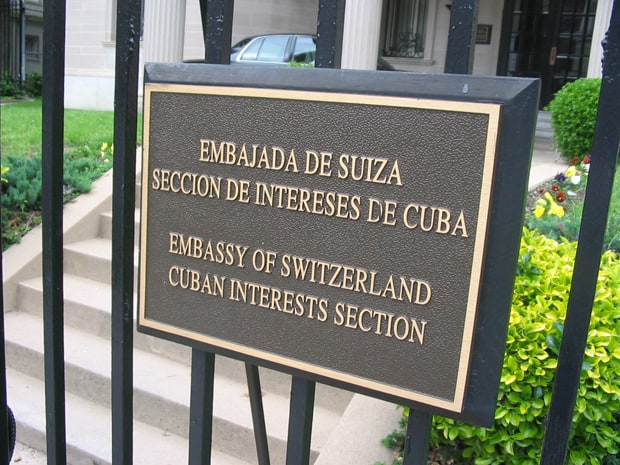WASHINGTON — Early Monday, before the public doors are opened and the day officially begins, the State Department will hang a new flag among the 192 banners displayed in its lobby atrium, a silent acknowledgment of the formal re-establishment of U.S.-Cuban diplomatic relations after more than 54 years.
A few hours later, Cuban Foreign Minister Bruno Rodríguez, on his first-ever visit to Washington, will raise his country’s flag in front of the 16th Street NW mansion that will once again become Havana’s embassy. In the afternoon, Rodríguez will meet and hold a joint news conference with Secretary of State John Kerry at the State Department.
Members of Congress who have long supported rapprochement between the countries will attend, along with an administration delegation headed by Assistant Secretary of State Roberta Jacobson.
President Barack Obama and Cuban President Raúl Castro set the date in an exchange of letters on July 1, nearly seven months after announcing the two governments would restore diplomatic ties.
While the Cubans hold their ceremony in Washington, an invitation-only event to be followed by a festive reception, the U.S. Embassy in Havana will quietly open for business without the Stars and Stripes. Officials said the flag-raising and festivities would await a visit from Kerry, expected early next month.
“Legally, the [U.S.] embassy will be functioning on Monday,” said a State Department official, who spoke on the condition of anonymity under rules imposed by the department. “It is not a legal requirement to fly a flag, and we wanted the secretary to be there to oversee these important events.” Kerry will also unveil new “signage” on the embassy, the official said.
Like its Washington counterpart, the U.S. Embassy in Havana once served that function, before relations were severed in January 1961 and the U.S.-Cuban deep freeze began. But while the American building is a squarely built example of the utilitarian architecture of the 1950s, Cuba’s embassy here has a long and colorful history.
As soon as the Cuban Embassy opened in 1919 in the Colonial revival mansion built for that purpose, it was a hit in Washington’s high society. One headline of the time enthused: “Cuban Legation Home: Style to be Louis Quinze, Building with Indiana Limestone Exterior and White Marble Interior Will Be One of the Handsomest Occupied by Diplomats in Washington.”
The building is considered significant in the capital’s architectural history because it was the first purpose-built embassy in the Meridian Hill neighborhood, then being established as a diplomatic center, according to a history compiled by David Maloney, the state historic preservation officer for the District.
Fidel Castro himself was feted at the embassy in April 1959, a few months after his guerrilla forces overthrew dictator Fulgencio Batista.
After relations were broken, the Cuban building in Washington — and the U.S. one in Havana — remained closed until 1977, when a thaw under President Jimmy Carter led to the establishment of Interests Sections, quasi-diplomat entities to handle bilateral affairs, under the auspices and protection of the Swiss government in both capitals.
Each country was allowed a small number of officials, and their movements were restricted outside Washington and Havana. The new diplomatic agreements that take effect Monday allow for an expanded presence and greater freedom of movement, although neither government has released the precise details.
The two governments have made clear that opening their embassies is only the first step on a long road to “normalization” and that they have many remaining differences on issues including the ongoing U.S. economic embargo and human rights, and outstanding legal claims against each other.
Neither side has named an ambassador yet, and the Obama administration has indicated that it may bide its time, as congressional opponents of its opening to Cuba have vowed to block any nominee. For now, Jeffrey DeLaurentis, the head of the Interests Section, will become chargé d’affaires in Havana, serving as the chief of mission.
By the time it was reoccupied nearly 40 years ago, the red carpet leading up the grand central stairway in the Cuban mansion had already faded. The parties at the Interests Section were never as glittering as in pre-revolutionary days. Instead, they tended to be low-key and political in nature — attended by representatives of supportive think tanks and members of Congress sympathetic to restoring ties, if not to Cuba’s Communist government.
Still, the annual Cuban cultural celebration in early January drew large crowds to sip free mojitos at a small bar called Hemingway’s set up in a salon. There was an especially large turnout as the new diplomacy got underway, with the guests including Virginia Gov. Terry McAuliffe.
Rodríguez, who will also hold meetings Monday on Capitol Hill, arrives Sunday night as the head of a 28-person delegation, including other high-ranking officials, former diplomats, and Cuban cultural and sports icons.
In recent weeks, the Cubans have painted inside the embassy-to-be and cleaned up the yard, replanting and mulching shrubbery beds. A new flagpole has been installed out front.
– – – – –
Washington Post staff writer David Montgomery contributed to this report.
© 2015, The Washington Post






